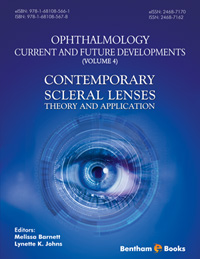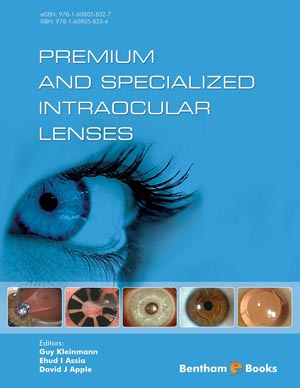Biography
Page: i-ii (2)
Author: Pedro Romero-Aroca and Manuel Montero-Jaime
DOI: 10.2174/9781681080321115010001
About the eBook
Page: iii-iii (1)
Author: Pedro Romero-Aroca and Manuel Montero-Jaime
DOI: 10.2174/9781681080321115010002
Foreword
Page: v-v (1)
Author: Pedro Romero-Aroca and Manuel Montero-Jaime
DOI: 10.2174/9781681080321115010003
Preface
Page: vii-vii (1)
Author: Pedro Romero-Aroca and Manuel Montero-Jaime
DOI: 10.2174/9781681080321115010004
List of Contributors
Page: ix-ix (1)
Author: Pedro Romero-Aroca and Manuel Montero-Jaime
DOI: 10.2174/9781681080321115010005
Ultrasonic Ocular Systems
Page: 3-10 (8)
Author: Manuel Montero-Jaime, Ariadna Conejero-Olesti and Pedro Romero- Aroca
DOI: 10.2174/9781681080321115010006
PDF Price: $15
Abstract
The ultrasound in ophthalmology took an important place, with multifrequency linear probe between 15 to 18 MHz, with higher definition than the old 7 MHz probe. This chapter describes the different types of ultrasound techniques, described the poorly used A-mode echography, and with reference to Color-Doppler ultrasound, and its normal ocular values.
B-mode Ultrasound of the Normal Eye
Page: 11-19 (9)
Author: Manuel Montero-Jaime, Pedro Romero-Aroca and Victor Perez- Riverola
DOI: 10.2174/9781681080321115010007
PDF Price: $15
Abstract
The ultrasound in ophthalmology held an important place, with multi-frequency linear probe being between 12 to 15 MHz, an obviously higher definition than the old 7 MHz probe. This chapter describes the different types of ultrasound techniques, with special reference to Color-Doppler ultrasound, and its normal ocular values.
Ultrasound of the Anterior Segment
Page: 21-32 (12)
Author: Isabel Méndez-Marín and Mónica Llagostera-Serra
DOI: 10.2174/9781681080321115010008
PDF Price: $15
Abstract
The ultrasound in anterior segment has a great number of limitations, despite in patients with ocular cataract or with intraocular lens [IOL], has an important place. Furthermore is useful in patients with iris pathologies [iris tumours], or in patients with malignant glaucoma. The most important technique for anterior segment examination with ultrasounds is the ultrasonic biomicroscopy [UBM] technique, based on 35-50 MHz probes. In the next chapter we describe the UBM examination of anterior segment and its application in different pathologies as cornea diseases or glaucoma.
Ultrasound in the Posterior Segment
Page: 33-63 (31)
Author: Pedro Romero-Aroca, Manuel Montero-Jaime, Marc Baget-Bernaldiz and Javier Reyes-Torres
DOI: 10.2174/9781681080321115010009
PDF Price: $15
Abstract
The ultrasound in posterior segment pathologies is the gold standard examination technique in cases of media opacities, when a cataract or vitreous hemorrhage exists. The first technique used to visualize the posterior segment is the echography. The ultrasound examination is fundamental in retina pathologies as retinal detachment in patients with cataracts. Its importance has been increased with the introduction of color Doppler echography which helps us in vasculophaties as arterial or venous occlusions or in patients with diabetic retinopathy. Furthermore, echography is useful in postoperative vitreous-retina patients, to detect new retinal detachments or peripheral new vessels growth in cases of recidivant hemorrhages.
Ocular Tumors
Page: 65-72 (8)
Author: Marc Baget-Bernaldiz, Nuria Soler and Manuel Montero-Jaime
DOI: 10.2174/9781681080321115010010
PDF Price: $15
Abstract
The posterior segment tumors are the most important indication for ultrasound examination. Echography is essential in choroid melanoma diagnosis; there are a lot of signs in echography which permit us to make a differential diagnosis with the other most frequent intraocular tumor, metastases which appeared with similar echographic signs in ultrasound examination. In the present chapter we also explain the characteristics of other tumors, as retinoblastoma or choroid hemangioms.
Color-Doppler Eye Scan Ultrasound
Page: 73-88 (16)
Author: Manuel Montero-Jaime, Pedro Romero-Aroca and Javier Reyes-Torres
DOI: 10.2174/9781681080321115010011
PDF Price: $15
Abstract
The Color-Doppler ultrasound introduced a new point of view in all ocular vasculopathies, thus the diabetic retinopathy [DR] can be studied based in the alterations in the ocular flux, currently DR is studied by scanning laser system, but this technique only permit us to view the intra retinal flux changes, but not the changes which succeed in choroid or in retro ocular vessels, which Color-Doppler ultrasound permit us to observe with an easy noninvasive examination. Furthermore the Color- Doppler echography is useful in patients with a decrease of vascular flux due to carotid insufficiency. Other pathologies as intraocular venous occlusions or arterial embolism produce typical signs in Color-Doppler echography. In this chapter we describe the basis of Color-Doppler examination for ocular vessels, the normal values for each vessel [ophthalmic artery or veins, central artery and vein, and for ciliary vessels], and the typical alterations observed in each vascular pathology.
Ultrasound and Ocular Trauma
Page: 89-99 (11)
Author: Pedro Romero-Aroca, Manuel Montero-Jaime and Demetrio A Ramos- Dominguez
DOI: 10.2174/9781681080321115010012
PDF Price: $15
Abstract
The ultrasound in ocular traumatism is an essential technique of examination. It is the gold standard technique in case of intraocular foreign body. In these patients magnetic resonance is completely avoided, in a possible metallic foreign body. The ocular trauma makes difficult the posterior segment visualization and echography helps us determine retina lesions, as retinal detachment. The echography is essential for determining intraocular foreign body location.
Ultrasound and Eye Surgery
Page: 101-122 (22)
Author: Pedro Romero-Aroca, Manuel Montero-Jaime, Nuria Soler and Jose A Buil-Calvo
DOI: 10.2174/9781681080321115010013
PDF Price: $15
Abstract
The ultrasound in ophthalmic surgery is essential in the preoperatory stage, when media opacities cause hindrance in the retina examination. When a patient is admitted for intraocular surgery, echography is mandatory to detect possible intraocular diseases as retinal detachment. In postoperative status, the patients need echographies if new media opacities appear as in case of postoperative hemorrhages in a vitrectomy surgery. In these cases the echography visualizes the posterior pole and permits to establish a correct diagnosis and a postoperative therapy.
Ultrasound Compared to Other Ocular Imaging Systems
Page: 123-132 (10)
Author: Pedro Romero-Aroca, Manuel Montero-Jaime, Marc Baget-Bernaldiz and Victor Perez-Riverole
DOI: 10.2174/9781681080321115010014
PDF Price: $15
Abstract
Ophthalmology in the last decades has seen a great rise in new images techniques. The appearance of fluorescein angiography, optical tomography, etc. Highlight that other image techniques are unnecessary. But in fact in the present years, the ocular echography has become important, and the advances with new probes with higher frequencies, has helped us in a lot of ocular pathologies, as seen in the last chapter. In the present chapter we describe the indications of other image techniques used in medicine, but with poor knowledge in ophthalmology. The authors describe the indications of computer tomography and magnetic resonance, and also define when we use each technique.
Subject Index
Page: 133-134 (2)
Author: Pedro Romero-Aroca and Manuel Montero-Jaime
DOI: 10.2174/9781681080321115010015
Introduction
This monograph expands on the ultrasound exploration of the ocular globe (or, in other words, the human eye) with a review of the current knowledge about ocular ultrasound techniques and its indications in ophthalmic pathology. Ocular echography has only been recently studied in greater detail by ophthalmologists thanks to new imaging techniques such as optical coherence tomography [OCT] and scanning lasers, which have become the preference in ocular exploration, relegating ultrasound to cases with poor fundus visualization. New ultrasound equipment with multi-frequency linear probes between 15 to 18 MHz, also permits technicians to observe ocular structures with greater detail. A key aspect of ultrasound is its dynamic capability, which allows assessing the displacement of intraocular structures and their relation to the different eye layers. This is crucial in diagnosing retina pathologies that can affect the outcome of cataract surgery. Ocular echography is also an excellent option to determine retinal lesions in cases of ocular tumors (choroid melanoma) as it is also a differential diagnosis for other tumors (metastasic tumors or hemangiomas). The book also includes a chapter on the use of Color-Doppler ocular examinations in the diagnosis of ocular vasculopathies (arterial or venous occlusions). Echography in Ocular Pathology empowers readers – ophthalmologists and clinical technicians – with the knowledge to diagnose different eye pathologies and thus ameliorate ophthalmic patient management.










.jpg)

